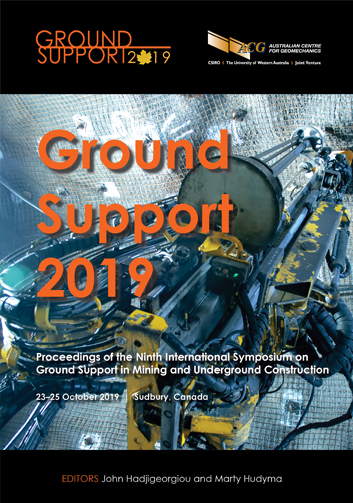Analysis of in situ and laboratory corrosion coupons

|
Authors: Chambers, AJ; Sunderman, CB; Clark, CC; Powers, MJ |
DOI https://doi.org/10.36487/ACG_rep/1925_28_Chambers
Cite As:
Chambers, AJ, Sunderman, CB, Clark, CC & Powers, MJ 2019, 'Analysis of in situ and laboratory corrosion coupons', in J Hadjigeorgiou & M Hudyma (eds), Ground Support 2019: Proceedings of the Ninth International Symposium on Ground Support in Mining and Underground Construction, Australian Centre for Geomechanics, Perth, pp. 415-422, https://doi.org/10.36487/ACG_rep/1925_28_Chambers
Abstract:
The corrosion of steel support components in the underground mine environment is a significant problem for the industry and has broad safety implications for mineworkers. The Spokane Mining Research Division (SMRD) of the National Institute for Occupational Safety and Health, located in Spokane, Washington, USA, is investigating the corrosion of ground support in underground metal mining. The goal of this research is to reduce risk to miner safety by preventing falls of ground caused by damaged ground support. This research paper presents the findings of field studies at collaborating mines and includes installation of corrosion coupons, mineralogical analysis, Internet-of-Things atmospheric monitoring, and rock mass resistivity measurements. Data collected from these studies inform understanding of corrosion rate, the environmental aggressors and inhibitors affecting corrosion, and the development of proactive mitigation tactics. Laboratory studies at SMRD complement the field studies through further investigation of the effects of corrosion on ground support integrity. Representative samples of ground support members exposed to real and simulated mine environments were evaluated for pitting, stress corrosion cracking, and mass loss. The outcomes of this research are advancements in real-time monitoring of the status of ground support systems, enhanced knowledge that can help engineers to plan and design safer work environments, and improved ground support systems that will better resist challenging environmental conditions in mines.
Keywords: corrosion, coupons, resistivity
References:
ASTM International 2005, Standard Guide for Using the Direct Current Resistivity Method for subsurface Investigation (ASTM D6431), ASTM International, West Conshohocken.
ASTM International 2011a, Standard Practice for Preparation and Use of Direct Tension Stress-Corrosion Test Specimens (ASTM G49-85(2011)), ASTM International, West Conshohocken.
ASTM International 2011b, Standard Practice for Preparing, Cleaning, and Evaluating Corrosion Test Specimens (ASTM G1-03), American Society for Testing and Materials, West Conshohocken.
ASTM International 2012, Standard Test Method for Measuring pH of Soil for Use in Corrosion Testing (ASTM G51-95(2012)), ASTM International, West Conshohocken.
ASTM International 2013a, Standard Guide for Examination and Evaluation of Pitting Corrosion (ASTM G46-94(2018)), ASTM International, West Conshohocken.
ASTM International 2013b, Standard Hardness Conversion Tables for Metals Relationship Among Brinell Hardness, Vickers Hardness, Rockwell Hardness, Superficial Hardness, Knoop Hardness, Scleroscope Hardness, and Leeb Hardness (ASTM E140-12b, ASTM International, West Conshohocken.
ASTM International 2016, Standard Practice for Making and Using U-Bend Stress-Corrosion Test Specimens (ASTM G30-97(2016), ASTM International, West Conshohocken.
Chambers, AJ, Sunderman, CB, Benton, DJ, Brennan, JT & Orr, DT 2017, ‘Evaluation and mapping of corrosion in a Western USA underground metal mine—year one preliminary results’, in J Wesseloo (ed.), Proceedings of the Eighth International Conference on Deep and High Stress Mining, Australian Centre for Geomechanics, Perth, pp. 785–798.
Dorion, JF & Hadjigeorgiou, J 2014, ‘Corrosion considerations in design and operation of rock support systems’, Mining Technology, vol. 123, no. 2, pp. 59–68.
Hassell, R 2008, Corrosion of Rock Reinforcement in Underground Excavations, PhD thesis, Curtin University of Technology, Bentley.
Lewis, M & Riggs Larsen, K 2017, ‘Historic corrosion tools tell the story of early corrosion control’, Materials Performance: Corrosion Prevention and Control Worldwide, vol. 56.
Peabody, AW 2001, Peabody’s Control of Pipeline Corrosion, 2nd edn, NACE International, Houston.
Polder, RB 2001, ‘Test methods for on site measurement of resistivity of concrete—a RILEM TC-154 technical recommendation’, Construction and Building Materials, vol. 15, no. 2, pp. 125–131.
Polder, RB 2009, ‘Critical chloride content for reinforced concrete and its relationship to concrete resistivity’, Materials and Corrosion, vol. 60, no. 8, pp. 623–630.
Potvin, Y, Nedin, P, Sandy, M, Rosengren, K & Rosengren, M 2001, Towards the Elimination of Rockfall Fatalities in Australian Mines, Australian Centre for Geomechanics, Perth.
© Copyright 2024, Australian Centre for Geomechanics (ACG), The University of Western Australia. All rights reserved.
View copyright/legal information
Please direct any queries or error reports to repository-acg@uwa.edu.au
View copyright/legal information
Please direct any queries or error reports to repository-acg@uwa.edu.au